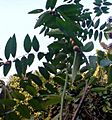Katuk facts for kids
Quick facts for kids Katuk |
|
|---|---|
 |
|
| Scientific classification | |
| Genus: |
Sauropus
|
| Species: |
androgynus
|
| Synonyms | |
|
List
|
|
Sauropus androgynus, often called katuk, star gooseberry, or sweet leaf, is a green plant that grows as a shrub. People in many tropical areas grow it to eat its leaves as a leaf vegetable.
This plant has many upright stems that can grow up to 2.5 meters (about 8 feet) tall. Its leaves are dark green and oval-shaped, usually 5–6 centimeters (about 2 inches) long.
Contents
Where Katuk Grows
Katuk is a very popular leafy vegetable in South Asia and Southeast Asia. It's known for growing a lot of leaves and tasting good. You can find it growing naturally in evergreen forests and in cultivated areas up to 1,300 meters (about 4,265 feet) high.
How People Use Katuk
The tips of the Katuk shoots are sometimes sold as "tropical asparagus." People use Katuk in many ways in different countries:
- In Vietnam, people often cook it with crab meat, minced pork, or dried shrimp to make a tasty soup.
- In Malaysia, it's commonly stir-fried with egg or dried anchovies.
- The plant's flowers and small purplish fruits can also be eaten.
- In Indonesia, the leaves are used to make a special drink. Some people believe this drink helps breastfeeding mothers produce more milk.
Katuk and Your Health
Katuk is a good source of important nutrients. It has a lot of vitamin K, which helps your blood clot and keeps your bones strong.
It also contains high levels of provitamin A carotenoids, especially in fresh leaves. These turn into vitamin A in your body, which is good for your eyes and immune system. Katuk is also rich in vitamin B and vitamin C, protein, and minerals. The older the leaves get, the more nutrients they seem to have!
However, it's important to know that eating too much raw Katuk can be harmful. In the 1990s, some people in Taiwan ate a lot of raw Katuk juice for weight control. This caused lung damage in some cases because the raw leaves have high amounts of a substance called papaverine.
To be safe, it's best to cook Katuk leaves, especially if you plan to eat a lot of them. Cooking seems to remove the harmful effects of this substance.
Katuk's Nutrition Facts
Katuk is a great source of beta-carotene, which your body turns into vitamin A. Just 100 grams (about 3.5 ounces) of Katuk can give you more than double your daily need for Vitamin C! It also provides a good amount of Iron and Zinc. However, Katuk also has things called polyphenols, like tannin, which can make it harder for your body to absorb all the zinc and iron.
Here's a quick look at what 100 grams of Katuk contains:
- Water: 91.4 grams
- Energy: 245 kJ
- Protein: 4.8 grams
- Fat: 1 gram
- Carbohydrates: 11 grams
- Calcium: 204 mg
- Iron: 3 mg
- Phosphorus: 98 mg
- Potassium: 457 mg
- Sodium: 25 mg
- Zinc: 0.94 mg
- Vitamin C: 239 mg
- Thiamin (Vitamin B1): 0.1 mg
- Vitamin A: 10370 IU
- Magnesium: 123 mg
- Manganese: 2400 mg
- Copper: 0.19 mg
- Riboflavin (Vitamin B2): 0.39 mg
- Niacin (Vitamin B3): 2.2 mg
- Pantothenic acid (Vitamin B5): 2.5 mg
Images for kids
See also
 In Spanish: Sauropus androgynus para niños
In Spanish: Sauropus androgynus para niños



